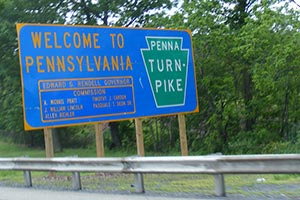Pennsylvania Set to Raise Speed Limit to 70 MPH on Bulk of Turnpike

In the wake of a trio of 20-month-old pilot programs during which the speed limit has been raised from 65 to 70 miles per hour on more than 200 miles of major highways in the state, Pennsylvania will unveil a permanent rise to 70 mph on 496 miles of its 552-mile turnpike (90%) in May. The exceptions will mostly be in work zones, tunnels, and urban and mountainous areas where the speed limit will remain 55 mph.
“Comparative analysis has been ongoing for almost two years so Turnpike Commissioners were comfortable that [we] can move ahead,” said Turnpike Commission spokesman Carl DeFebo, whose agency administers the 100 miles on the turnpike in the western half of the state which have been 70 mph since August 2014. “The conversion will mean more consistency for turnpike motorists.”
The Pennsylvania Trucking Association supports the increase.
“Many of my members have governors that are set at 65-68 mph,” said PMTA CEO Jim Runk. “Maybe there’s a chance that an accident can be more violent at the new speed, but I don’t know that another one or two miles per hour will make a difference.”
However, the move to 70 mph alarms The Insurance Institute for Highway Safety, which said that although safety measures cut highway traffic deaths nationally by about 20% from 1993-2013, an additional 33,000 deaths occurred because of higher speed limits. Congress repealed the national maximum speed limit of 65 mph in 1995. Thirty three states have since set higher speed limits.
“We’ve seen fatalities in crashes decline over the years because [of] all the technology in the vehicles, but when you raise the speed limit, it’s kind of like two steps forward and one step back,” said Charles Farmer, vice president of research at IIHS, who attributed more than 1,900 deaths last year to the higher speed limits.
“We learn as kids that falling down while running hurts a lot more than falling down while walking. Speed makes things more serious. If people are going faster and they get into a crash, they’re definitely going to have a higher risk of serious or even fatal injuries. I think [state transportation officials] don’t realize anymore how serious it is to be going that fast.”
Rich Kirkpatrick, a spokesman for Pennsylvania’s Department of Transportation, which administers the pilot programs on more than 100 miles of interstates 80 and 380 in the state’s eastern half which began in August 2014, strongly disagreed that Pennsylvania was being reckless with drivers’ lives.
“We’ve taken a very careful approach,” said Kirkpatrick, noting that Penn State’s School of Engineering was hired to help choose segments that could be safely designated as 70 mph. “We haven’t seen anything that jumped out at us in the way of crashes. If we had seen a dramatic increase [in crashes], we would reconsider.”
PennDot’s data for the three months before and after the pilots went into effect in August 2014 showed that the majority of trucks averaged 68 mph before and 70.3 after with cars rising from 74 mph to 74.7. The percentage of trucks and cars exceeding the speed limit plummeted after the change.

